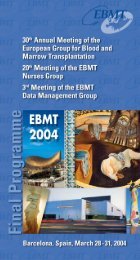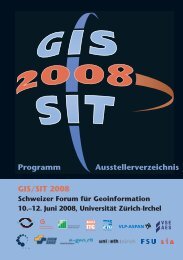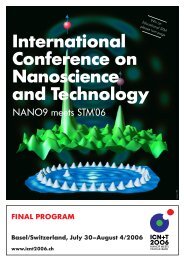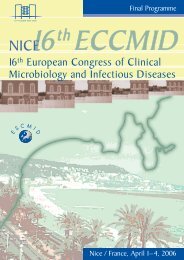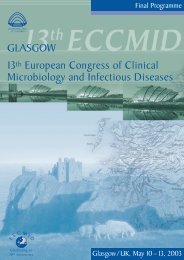14th European Congress of Clinical Microbiology and Infectious ...
14th European Congress of Clinical Microbiology and Infectious ...
14th European Congress of Clinical Microbiology and Infectious ...
You also want an ePaper? Increase the reach of your titles
YUMPU automatically turns print PDFs into web optimized ePapers that Google loves.
Poster Sessions Monday, May 3, 2004<br />
12:00–13:00<br />
Molecular bacteriology: borrelia<br />
P952 Isolation <strong>and</strong> identification <strong>of</strong> Borrelia strains<br />
from ticks collected in the Czech Republic<br />
H. Drevová, D. Hulínská, J. Plch, Z. Kurzova<br />
(Prague, CZ)<br />
P953 Identification <strong>of</strong> Lyme disease spirochetes in<br />
humans <strong>and</strong> animals<br />
D. Hulínská, J. Voty‘pka, H. Drevová, K. Langrova,<br />
M. Bojar, M. Valesˇová (Prague, CZ)<br />
P954 Diversity <strong>of</strong> Borrelia burgdorferi sensu lato in<br />
the Russian Far East<br />
O. Mediannikov, L. Ivanov, N. Zdanovskaya,<br />
R. Vorobyova, P.-E. Fournier, I. Tarasevich, D. Raoult<br />
(Moscow, Khabarovsk, RUS; Marseille, F)<br />
P955 A new recombinant IgG <strong>and</strong> IgM line<br />
immunoblot improves serodiagnosis <strong>of</strong> early<br />
Lyme borreliosis<br />
G. Goettner, U. Schulte-Spechtel, V. Fingerle,<br />
G. Liegl, B. Wilske (Munich, D)<br />
P956 The first study <strong>of</strong> identification <strong>of</strong> Borrelia,<br />
Ehrlichia <strong>and</strong> Babesia in Ixodes ricinus ticks<br />
from Lithuania using molecular methods<br />
D. Ambrasiene, I. Vascilo, A. Jenkins,<br />
A.-G. Allum, L. Str<strong>and</strong>, B.-E. Kristiansen<br />
(Kaunas, Vilnius, LIT; Bo i Telemark, Skien, N)<br />
12:00–13:00<br />
Molecular bacteriology: characterisation <strong>of</strong><br />
agents<br />
P957 Improved automated ribotyping using HindIII<br />
to discriminate previously uniform Listeria<br />
monocytogenes serotype 4b strains<br />
I. Heller, K. Grif, M. Dierich, R. Würzner<br />
(Innsbruck, A)<br />
P958 Detection <strong>of</strong> BFT, the is<strong>of</strong>orms <strong>of</strong> the<br />
enterotoxin gene <strong>and</strong> cfiA gene in Bacteroides<br />
fragilis isolates <strong>of</strong> different origins<br />
G. Terhes, J. Soki, K. Ago, E. Urban, E. Nagy<br />
(Szeged, HUN)<br />
P959 Prevalence <strong>and</strong> characterisation <strong>of</strong> binary<br />
toxin (actin specific ADP-ribosyltransferase)<br />
from Clostridium difficile<br />
D. Decré, F. Barbut, C. Goncalves, B. Burgh<strong>of</strong>fer,<br />
J.-C. Petit (Paris, F)<br />
P960 Molecular characterisation <strong>and</strong> prevalence <strong>of</strong><br />
Clostridium difficile in Singapore<br />
W.Y. Leong, R. Das Ramadas, T.H. Koh, K.P. Song<br />
(Singapore, SGP)<br />
page 94 Final Programme<br />
P961 Characterisation <strong>of</strong> Clostridium difficile<br />
strains isolated in different time periods <strong>and</strong><br />
belonging to different ribotypes<br />
P. Spigaglia, V. Carucci, P. Mastrantonio (Rome, I)<br />
P962 Virulence in enterococci: chromosomal versus<br />
plasmidic location <strong>of</strong> virulence genes<br />
T.M. Leitão Semedo, M.F. Silva Lopes,<br />
J.J. Figueiredo Marques, M.T. Barreto Crespo,<br />
R. Tenreiro (Lisbon, P)<br />
P963 Identification <strong>of</strong> salmonella serotypes in<br />
sheep by PCR<br />
T. Zahraei-Salehi (Tehran, IR)<br />
P964 Molecular typing <strong>of</strong> Salmonella enterica<br />
serotype Typhimurium strains from Slovak<br />
Republic<br />
H. Drahovská, E. Mikasová, E. Kaclíková,<br />
R. Karpísˇková, M. Sásik, J. Turna<br />
(Bratislava, SK; Brno, CZ)<br />
P965 Detection <strong>of</strong> fimbrial adhesin genes in<br />
ESBL-producing Klebsiella strains isolated<br />
from nosocomial infections<br />
K. Matusiewicz, B. Maczynska, D. Olejniczak,<br />
A. Przondo-Mordarska, R. Franiczek<br />
(Wroclaw, PL)<br />
P966 Development <strong>and</strong> validation <strong>of</strong> Amplified<br />
Fragment Length Polymorphism (AFLP)<br />
for molecular epidemiology <strong>and</strong> identification<br />
<strong>of</strong> Klebsiella pneumoniae <strong>and</strong> Klebsiella<br />
oxytoca phylogenetic groups<br />
D. Jonas, B. Spitzmüller, F.D. Daschner,<br />
J. Verhoef, S. Brisse<br />
(Freiburg, D; Utrecht, NL; Paris, F)<br />
P967 Molecular serotyping <strong>of</strong> Klebsiella by<br />
restriction <strong>of</strong> the amplified capsular antigen<br />
gene cluster<br />
S. Brisse, S. Issenhuth-Jeanjean, P.A.D. Grimont<br />
(Paris, F)<br />
P968 Cloning <strong>of</strong> 16S rRNA genes amplified from<br />
normal <strong>and</strong> disturbed vaginal micr<strong>of</strong>lora<br />
points to a strong assocation between<br />
Atopobium vaginae, Gardnerella vaginalis<br />
<strong>and</strong> bacterial vaginosis<br />
R. Verhelst, H. Verstraelen, G. Claeys,<br />
G. Verschraegen, J. Delanghe, L. Van Simaey,<br />
C. De Ganck, M. Temmerman, M. Vaneechoutte<br />
(Ghent, B)<br />
P969 Molecular typing <strong>of</strong> Vibrio cholerae strains<br />
having different sets <strong>of</strong> “pathogenicity<br />
isl<strong>and</strong>s”<br />
E.A. Kostromitina, G.A. Yeroshenko,<br />
N.I. Smirnova (Saratov, RUS)



